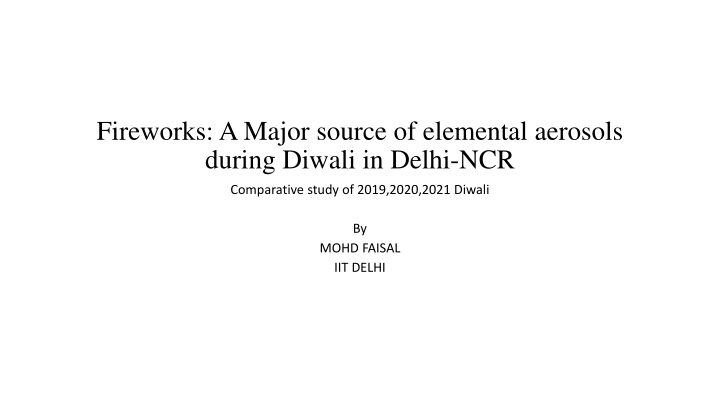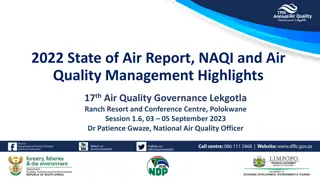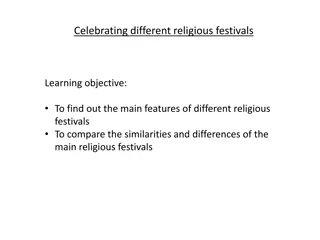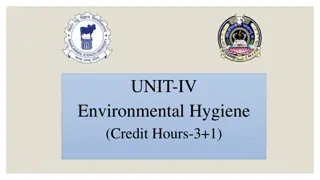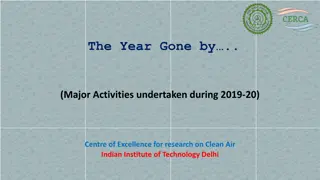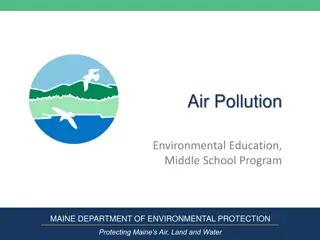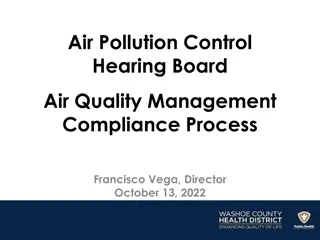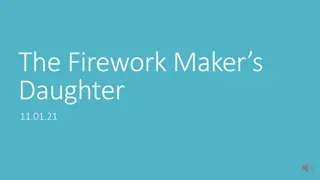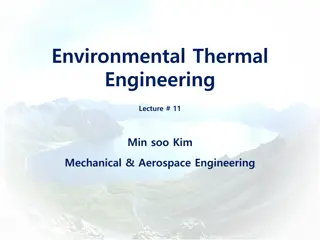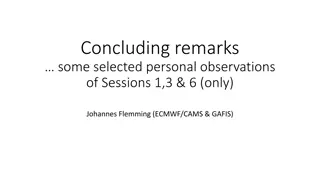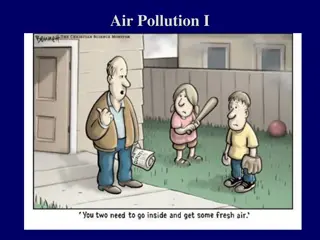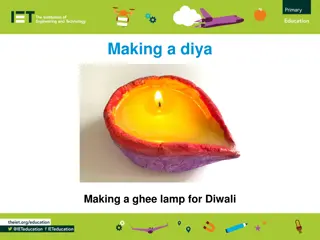Fireworks Impact on Delhi's Air Quality During Diwali
Fireworks during Diwali in Delhi-NCR are a significant source of elemental aerosols, contributing to elevated PM2.5 levels and altering chemical compositions. Research highlights the release of K+, Cl-, S, and the impact on PM concentration. A comparative study from 2019 to 2021 shows variations in aerosol concentrations. Factors like ambient metal monitoring and chemical speciation analysis were used to quantify the impact, revealing insights on particle-bound metallic concentrations.
Download Presentation

Please find below an Image/Link to download the presentation.
The content on the website is provided AS IS for your information and personal use only. It may not be sold, licensed, or shared on other websites without obtaining consent from the author.If you encounter any issues during the download, it is possible that the publisher has removed the file from their server.
You are allowed to download the files provided on this website for personal or commercial use, subject to the condition that they are used lawfully. All files are the property of their respective owners.
The content on the website is provided AS IS for your information and personal use only. It may not be sold, licensed, or shared on other websites without obtaining consent from the author.
E N D
Presentation Transcript
Fireworks: A Major source of elemental aerosols during Diwali in Delhi-NCR Comparative study of 2019,2020,2021 Diwali By MOHD FAISAL IIT DELHI
Research highlights Fireworks are a direct and indirect sources of various organic and inorganic particles. Fireworks during diwali release large amounts of K+, Cl , S. The burning of firecrackers elevated PM2.5 in a short time. The burning of firecrackers changed the chemical compositions of PM2.5 Average concentration on Diwali day 2020 was 107ug/m3, around 1.5 times less than (154ug/m3) compared to 2019 Diwali day, whereas concertation increase to 137 ug/m3 in 2021.
Data and Methods Instrumentation Xact 625i Ambient Metal Monitor Quadruple-Aerosol Chemical Speciation Monitor . Methodology A multivariate method was applied for factor analyses known as the Positive Matrix Factorization (PMF) (Paatero and Tapper, 1994).
Quantifying the impact of Diwali fireworks on PM concentration in Delhi Manchanda, C., Kumar, M., Singh V.et al. (2020). Chemical characterization of PM2.5 bound species during the Diwali fireworks in Delhi: An insight from source apportionment and airborne hazardous elements. Preprint: https://arxiv.org/abs/2011.14402 --Extended Pre-Diwali phase (ePD) (20th October 2019 24:00 IST 27th October 2019 18:00 IST) --Pre-Diwali (PD) (25th October 2019 24:00 IST 27th October 2019 18:00 IST) --During Diwali (DD) (27th October 2019 18:00 IST 28th October 2019 6:00 IST) --Following Diwali (FD) (28th October 2019 6:00 IST 31st October 2019 24:00 IST)
Quantifying the impact of Diwali fireworks on PM concentration in Delhi Particle bound metallic concentration during Diwali in Delhi v/s the EPA risk based screening levels for industrial and residential air PMF resolved Fireworks factor and corresponding temporal variation
Extending fireworks study to the multiyear
0.1 (0.1%) 1 (0.8%) 0.1 (0.1%) 3.1 (2.6%) 3.4 (2.8%) 2.5 (1.4%) 0.4 (0.3%) 0.1 (0.1%) 3.5 (2.4%) Secondary Cholride Dust Related Vehicular emmission Power Plant Waste incineration Biomass Burning Industrial Pb-rich Fireworks 3.2 (1.8%) 3.3 (2.7%) 14.4 (8.1%) 0.5 (0.3%) 2.5 (1.7%) 5 (4.1%) 1.1 (0.6%) 2.7 (1.9%) Summary of the Results 0.1 (0.1%) 1.2 (0.7%) 0.5 (0.3%) 0.3 (0.2%) 0.1 (0.1%) 0.2 (0.1%) 155.9 (87.1%) 104.3 (86.7%) 137.5 (93.1%) 2019 FD PD DD 350 PD DD FD 300 2020 200 PM 2.5 El (ug/m3) 250 180 160 200 PM 2.5 EL (ug/m3) 140 150 120 100 100 80 50 60 0 40 20-10-2019 23-10-2019 26-10-2019 29-10-2019 Date 01-11-2019 04-11-2019 20 0 11-11-2020 PD 13-11-2020 15-11-2020 17-11-2020 FD DD 2021 Date 200 PM 2.5 El (ug/m3) 150 Total PM2.5 100 Elemental PM2.5 50 0 31-10-2021 02-11-2021 04-11-2021 Date 06-11-2021 08-11-2021
Diwali Fireworks Comparison 2019 Diwali Fireworks Comparison 2019- -21 Total PM 2.5 DD 21 34 Total PM 2.5 DD 700 1000 600 Total PM 2.5 (ug/m3) Total PM 2.5 (ug/m3) 800 500 400 600 300 400 200 200 100 0 0 10-11-2020 12-11-2020 14-11-2020 16-11-2020 18-11-2020 20-11-2020 20-10-2019 23-10-2019 26-10-2019 29-10-2019 01-11-2019 04-11-2019 Date Date Total PM 2.5 DD 700 Total PM2.5 ( g/m3) 600 Total PM 2.5 (ug/m3) 500 2019 2020 2021 400 300 Max 550 640 653 200 Min 160 207 302 100 0 Average 361 460 501 30-10-2021 01-11-2021 03-11-2021 05-11-2021 07-11-2021 09-11-2021 Date 12h average PM2.5 during Diwali night 2019 < 2020 < 2021
35 PM 2.5 El PD DD FD PM 2.5 EL PD DD FD 350 200 300 180 160 250 PM 2.5 El (ug/m3) PM 2.5 EL (ug/m3) 140 120 200 100 150 80 60 100 40 50 20 0 0 11-11-2020 12-11-2020 13-11-2020 14-11-2020 15-11-2020 16-11-2020 Date 17-11-2020 18-11-2020 19-11-2020 20-11-2020 20-10-2019 22-10-2019 24-10-2019 26-10-2019 28-10-2019 30-10-2019 01-11-2019 03-11-2019 05-11-2019 Date PM 2.5 El PM2.5, EL ( g/m3) 200 PM 2.5 El (ug/m3) 150 2019 2020 2021 100 Max 294.8 175.6 206.5 Min 46.8 46.9 79.7 50 Average 175.0 116.7 151.3 0 31-10-2021 01-11-2021 02-11-2021 03-11-2021 04-11-2021 05-11-2021 Date 06-11-2021 07-11-2021 08-11-2021 09-11-2021 10-11-2021 12-hour average concentration of metals during Diwali night 2020 < 2021 < 2019
36 Fireworks 2020 180 Firework 2019 300 160 140 250 Conc. (ug/m3) 120 Conc. (ug/m3) 200 100 150 80 60 100 40 50 20 0 0 11-11-2020 13-11-2020 15-11-2020 17-11-2020 19-11-2020 21-11-2020 21-10-2019 23-10-2019 25-10-2019 27-10-2019 29-10-2019 31-10-2019 02-11-2019 04-11-2019 06-11-2019 Date Date Fireworks Factor ( g/m3) Firework 2021 200 2021 2019 2020 150 Conc.(ug/m3) Max 242.4 166.6 200.1 100 Min 33.9 29.6 64.8 50 Average 154.0 108.8 137.4 0 31-10-2021 02-11-2021 04-11-2021 06-11-2021 08-11-2021 Date 12h average concentration of firework factor during Diwali night Impact of lockdown (2020) and increasing firecracker restrictions (2021) Other sources were relatively more important in 2020 and 2021 further analysis underway 2020 < 2021 < 2019
Fireworks:Also a source of oragnics
Fireworks: Also, a source of organics K(ug/m3) Fireworks(elements) K(ug/m3) Fireworks(elements) OOA (FW) OOA (FW) 220 220 (21:00 hrs-06:00 hrs) PD DD FD 0.682582761 OOA(FW AND K) 110 110 0.682582761 0.64315814 0.64315814 OOA(FW AND K) OOA (FW and FW) OOA (FW and FW) 200 200 180 180 105 105 Organics 113 295 - 160 160 Conc. (ug/m3) Conc. (ug/m3) 100 100 Conc. (ug/m3) Conc. (ug/m3) 140 140 120 120 95 95 NH3 13 42 - 100 100 90 90 80 80 85 85 60 60 NO3 10 35 - 40 40 80 80 20 20 0 0 1 1 2 2 3 3 4 4 5 5 6 6 7 7 8 8 Time Time FW-OOA is likely mixed with the aerosol produced by the burning of binding agents, such as dextrin or shell paper The FW-OOA is related to the organic aerosol released from FW, as shown by co-varying trends with the K and the elemental fireworks factor during Diwali night. Mass spectra of the FW-OOA was similar to the MO-OOA (more oxidized organic aerosol) factors that indicates that FW-OOA was highly oxidized or secondary, having been rapidly oxidized in the high temperatures of FW burning.
Conclusions and Future Work This work demonstrates the potential influence of firecracker combustion and stubble burning on PM2.5 aerosol concentration after Diwali night. The results of this work can be essential for guiding policies and to control strategies to alleviate haze events in such firework events. The reported enhancement in the mass concentration of elemental metals like Al, Ba, Cl, Pb, and Mn poses a severe threat to the health of the exposed population as the average mass concentration of these species exceeded the standard EPA risk-based levels by orders of magnitude during the DD phase. Moreover, possible carcinogens like As also exceeded the risk-based concentration by magnitude. The Diwali festival frequently overlaps with the harvesting season and increased stubble-burning events negatively influence ambient air quality. These overlapping occurrences often make determining either impact on ambient air pollution challenging. Biomass burning (Organics factor) Biomass burning (Elemnetal factor) DD Future Work FD PD 120 100 Conc. (ug/m3) 80 60 40 20 0 30-10-2021 31-10-2021 01-11-2021 02-11-2021 03-11-2021 04-11-2021 05-11-2021 06-11-2021 07-11-2021 08-11-2021 09-11-2021 10-11-2021
